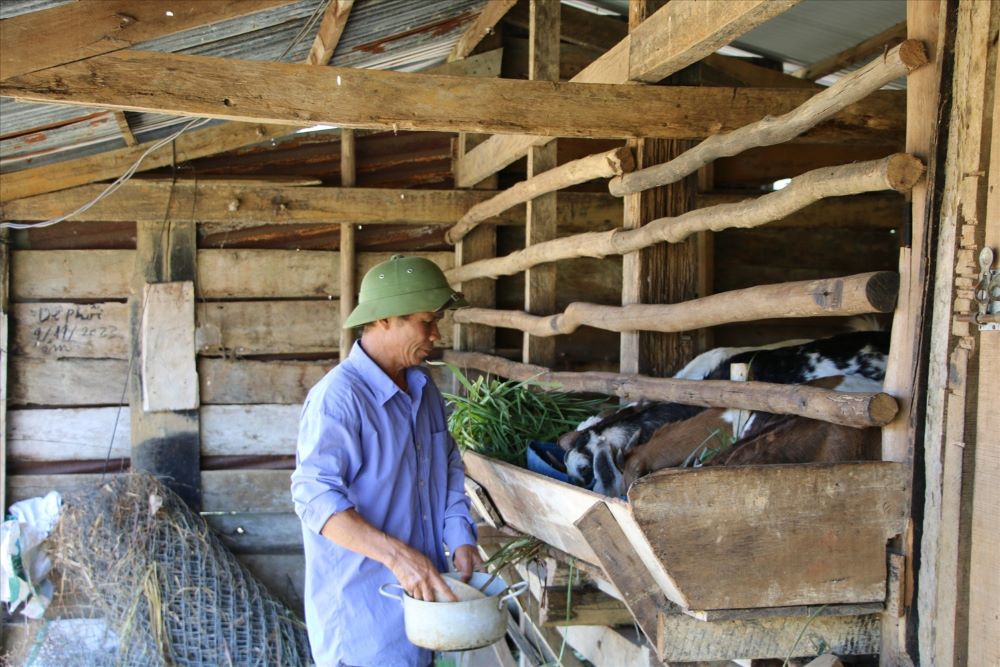Investing in infrastructure for villages
Dak Nong province has 40 ethnic groups living together. Of these, nearly 213,000 people are ethnic minorities, accounting for 31% of the province's population.
Over the years, the Party and State have always paid attention and invested resources in ethnic minority areas. For example, the National Target Program for Sustainable Poverty Reduction.
From this resource, localities of Dak Nong province have implemented it extensively, drastically, specifically, with addresses, and to the right beneficiaries... Thereby, contributing to changing the face of ethnic minority areas in the area.
In Krong No district, there are 24 ethnic groups living together. In recent times, many communes in Krong No district have improved, people's lives have stabilized and developed.
Essential infrastructure works have been put into use to meet the production and living needs of the people. Many models supporting production development and supporting seedlings have been effective... contributing to rapidly reducing the poverty rate among ethnic minorities.
For example, Hamlet 9 is a particularly difficult hamlet in Dak Dro commune, Krong No district. The whole hamlet has 320 households and more than 1,300 people. Of which, 115 households are ethnic minorities, most of whom are M'Nong.
From the resources of the Central Government, Hamlet 9 and its people have benefited greatly. According to Mr. Mai Van Thuong, Head of Hamlet 9, previously, the main road of the hamlet had no drainage system, the terrain was hilly and muddy, making it extremely difficult to travel during the rainy season.
Thanks to the attention of the Party and the State, the village's road has been invested in, upgraded, and expanded by nearly 600m, with a total investment of 1.6 billion VND. In addition, people in village 9 are also supported with breeding animals, creating a long-term livelihood.

Giving livelihood to people
The family of Mr. Y Thanh, M'nong ethnic group, village 9, Dak Dro commune, was previously in difficult circumstances. In early 2023, through Project 2, Diversifying livelihoods, developing poverty reduction models under the National Target Program for Sustainable Poverty Reduction for the period 2021 - 2025, he was supported with a cow farming model.
In addition to providing breeding cows, the locality also helps Mr. Y Thanh's family with grass seeds, veterinary techniques and methods, and livestock care and development.
With the encouragement to develop his livelihood, Mr. Y Thanh has learned from experience, attended training courses, and made efforts to care for the cows so that they grow well. Earlier this year, the breeding cow gave birth, providing him with additional economic resources.
Along with that, Mr. Y Thanh's family also borrowed 40 million VND from the interest rate support policy for local ethnic minority households. The preferential loan capital was invested by him in taking care of crops and improving production efficiency on the same land area.
According to Mr. Ngan Thanh Hai, Head of the Ethnic Affairs Department of Krong No district, the province's specific policies and national target programs have promoted the development of agriculture, trade services, transportation, education, health care, social culture, etc. in ethnic minority areas.
Infrastructure in villages and hamlets populated by ethnic minorities has been gradually invested in and built, basically meeting the production and living needs of the people.
The lives of poor and near-poor households in ethnic minority areas have improved. The rate of poor and near-poor households according to the basic multidimensional poverty standard has decreased over the years.
In 2019, the entire Krong No district had 1,229 poor households, accounting for 6.3%; of which, ethnic minority poor households were 887 households. By 2023, the district's poor households had decreased to 748 households, accounting for 3.7%; of which, ethnic minority poor households were 560 households.
In the coming time, the district will also organize the synchronous, effective, and focused implementation of national target programs, associated with mobilizing and effectively using investment resources for ethnic minority areas.
Thereby, developing infrastructure, creating sustainable livelihoods on the basis of promoting the potential and strengths of ethnic minority areas...
Speaking at the opening ceremony of the 4th Congress of Ethnic Minorities in Dak Nong province recently, Ms. Ton Thi Ngoc Hanh, Vice Chairwoman of the Provincial People's Committee and Head of the Congress Steering Committee, said that thanks to good ethnic work and policies, the poverty rate in Dak Nong province has decreased, exceeding the planned target.
At the end of 2019, the overall poverty rate in the province was 10.5%. Of which, the poverty rate of ethnic minority households was 24.2%.
By the end of 2023, the overall poverty rate in the province will decrease to 5.2%, of which the poverty rate of ethnic minorities will decrease to 13.2%.
In the 2021-2024 period, the poverty rate will decrease by an average of 2%. Of which, the poverty rate of ethnic minority households will decrease by 6.87%, exceeding the set target of 4-5%.
With the above results, Dak Nong has become a bright spot in poverty reduction, caring for the lives of people and ethnic minorities. Dak Nong is also the leading province in the Central Highlands region in poverty reduction.












